Assessment of Selected Structural Properties of High-Speed Friction Welded Joints Made of Unalloyed Structural Steel
Abstract
1. Introduction
2. Materials and Methods
3. Results and Discussion
3.1. Metallographic Investigation
3.2. Hardness
3.3. EBSD-Investigation
4. Conclusions
- it is possible to obtain correct joints in a very short time (60 ms). The obtained friction joints resembled an hourglass, therefore the tests carried out at different radius of the friction joint (in the axis and on the radius) showed differences in the degree of deformation and refinement of the microstructure of individual zones of the friction joint. Measurement of the grain size according to EN ISO 643: 2012 (for an observation field of 120 µm × 100 µm) showed grain refinement in the friction weld to an average of 1.27 µm2, and in HAZ 1.76 µm2. The average grain size of the base material was 21 µm2. The analysis of hardness distributions showed that these areas (at the axis and on the radius) also differ in the degree of strengthening of the microstructure. In the extreme case, the hardness of the friction weld increased above 340 HV0.1. Too high an increase in the hardness of the joint may cause its sensitive to dynamic or fatigue loads.
- The results of the EBSD-investigation (for an observation field of 25 µm × 25 µm) confirmed the strong refinement of the average grain size in the friction joint up to 300 µm from the friction plane. The microstructure in this area is also characterized by a high share (>80%) of high-angle grain boundaries and a share of recrystallized grains at the level of 70%. The results show that during high-speed friction welding, the phenomenon of dynamic recrystallization took place, but also that it is possible to obtain conditions like those existing during High Pressure Torsion (the method used to produce UFG materials). At the same time, as they moved away from the friction weld, the average grain size increased, and the share of the recrystallized grains fraction decreased. And at 300 µm from the center of the friction weld, another decrease in the average grain size, observation on the optical microscope also showed the occurrence of normalization.
- The width of the zone where the friction welding cycle causes changes in microstructure and hardness is comparable. Hardness distribution is not closely related to grain size distribution. Grain size and reorientation of the crystals are not the only factors shaping hardness. The character of the thermal cycle of friction welding and the gradient temperature distribution are of great importance.
- The task with a very short time of friction <1 s and high values of rotational speed and unit pressure in the friction phase resulted in the creation of a sharp gradient of microstructural properties of the joint. Such severe conditions of friction welding generated significant changes in the material properties in the joint zone.
Author Contributions
Funding
Institutional Review Board Statement
Informed Consent Statement
Data Availability Statement
Conflicts of Interest
References
- Ou, Y.; Deng, Y.; Zhang, W.; Zhao, Y.; Zeng, J. Effect of friction time on heat distribution, material flow, and microstructure of friction welding of dissimilar steels. Proc. Inst. Mech. Eng. Part L J. Mater. Des. Appl. 2022. [Google Scholar] [CrossRef]
- Bouarroudj, E.-o.; Chikh, S.; Abdi, S.; Miroud, D. Thermal analysis during a rotational friction welding. Appl. Therm. Eng. 2017, 110, 1543–1553. [Google Scholar] [CrossRef]
- Li, H.; Liu, X.; Zhang, Y.; Yuan, T.; Hodúlová, E.; Šimeková, B.; Bober, M.; Senkara, J.; Li, Z. Influence of the rotation speed on the interface microstructure and joining quality of aluminum alloy 6061/CF-PPS joints produced by refill friction stir spot welding. Weld. World 2022, 66, 923–933. [Google Scholar] [CrossRef]
- Adin, M.Ş.; Okumuş, M. Investigation of Microstructural and Mechanical Properties of Dissimilar Metal Weld Between AISI 420 and AISI 1018 STEELS. Arab. J. Sci. Eng. 2022, 47, 8341–8350. [Google Scholar] [CrossRef]
- Hasegawa, M.; Ieda, T. Effects of friction welding conditions on initial joining phenomena. Weld. Int. 1999, 17, 24–34. [Google Scholar] [CrossRef]
- Baffari, D.; Buffa, G.; Campanella, D.; Fratini, L.; Micari, F. Friction based solid state welding techniques for transportation industry applications. Procedia CIRP 2014, 18, 162–167. [Google Scholar] [CrossRef]
- Hongjun, L.; Bowen, C.; Huangyu, G.; Bingxu, W.; Jian, Z. Multilayer friction surfacing of AA6061 aluminum alloy on 316L steel plate. Proc. Inst. Mech. Eng. Part L J. Mater. Des. Appl. 2022. [Google Scholar] [CrossRef]
- Bowden, F.P.; Persson, P.A. Deformation, heating and melting of solids in high-speed friction. Proc. R. Soc. Lond. Ser. A. Math. Phys. Sci. 1961, 260, 433–458. [Google Scholar] [CrossRef]
- Jin, F.; Li, J.; Liu, P.; Nan, X.; Li, X.; Xiong, J.; Zhang, F. Friction coefficient model and joint formation in rotary friction welding. J. Manuf. Process. 2019, 46, 286–297. [Google Scholar] [CrossRef]
- Adin, M.Ş.; İşcan, B.; Baday, Ş. Optimization of Welding Parameters of AISI 431 and AISI 1020 Joints Joined by Friction Welding Using Taguchi Method. BSEU J. Sci. 2022, 9, 453–470. [Google Scholar] [CrossRef]
- Skowrońska, B.; Chmielewski, T.; Pachla, W.; Kulczyk, M.; Skiba, J.; Presz, W. Friction weldability of UFG 316L stainless steel. Arch. Metall. Mater. 2019, 64, 1051–1058. [Google Scholar] [CrossRef]
- Skowrońska, B.; Chmielewski, T.; Kulczyk, M.; Skiba, J.; Przybysz, S. Microstructural investigation of a friction-welded 316l stainless steel with ultrafine-grained structure obtained by hydrostatic extrusion. Materials 2021, 14, 1537. [Google Scholar] [CrossRef] [PubMed]
- Morawiński, Ł.; Jasiński, C.; Ciemiorek, M.; Chmielewski, T.; Olejnik, L.; Lewandowska, M. Solid-state welding of ultrafine grained copper rods. Arch. Civ. Mech. Eng. 2021, 21, 89. [Google Scholar] [CrossRef]
- Siedlec, R.; Strąk, C.; Zybała, R. Morfologia złączy kompozytów Al/Al2O3 zgrzewanych tarciowo ze stopem Al 44200. Przegląd Spaw.-Weld. Technol. Rev. 2016, 88, 9–13. [Google Scholar] [CrossRef]
- Miara, D.; Matusiak, J.; Pietras, A.; Świetlik, M.; Zitti, S. Application of a device for the production of electrovalves by High Speed Friction Welding HSFW and FSW welding. Weld. Technol. Rev. 2019, 91, 33–40. [Google Scholar] [CrossRef]
- Skowrońska, B.; Bober, M.; Kołodziejczak, P.; Baranowski, M.; Kozłowski, M.; Chmielewski, T. Solid-State Rotary Friction-Welded Tungsten and Mild Steel Joints. Appl. Sci. 2022, 12, 9034. [Google Scholar] [CrossRef]
- Włosiński, W.; Chmielewski, T.; Kucharczyk, M. Friction welding of NiAl and FeAl alloys with St3S carbon steel. Weld. Technol. Rev. 2004, 76, 6–12. [Google Scholar]
- Miara, D.; Matusiak, J.; Pietras, A.; Krystian, M.; Dyner, M. High speed friction welding of titanium alloys—Structure and properties of joints. Pat. Weld. J. 2018, 2018, 40–42. [Google Scholar] [CrossRef]
- Gorka, J. Welding technologies for the removal of defects in welded joints and iron-castings. Weld. Int. 2002, 16, 341–346. [Google Scholar] [CrossRef]
- Świerczyńska, A.; Fydrych, D.; Łabanowski, J. The Effect of Welding Conditions on Diffusible Hydrogen Content in Deposited Metal. Solid State Phenom. 2011, 183, 193–200. [Google Scholar] [CrossRef]
- Li, P.; Li, J.; Li, X.; Xiong, J.; Zhang, F.; Liang, L. A study of the mechanisms involved in initial friction process of continuous drive friction welding. J. Adhes. Sci. Technol. 2015, 29, 1246–1257. [Google Scholar] [CrossRef]
- Shukla, S.; Komarasamy, M.; Mishra, R.S. Grain size dependence of fatigue properties of friction stir processed ultrafine-grained Al-5024 alloy. Int. J. Fatigue 2018, 109, 1–9. [Google Scholar] [CrossRef]
- Wang, G.; Li, J.; Wang, W.; Xiong, J.; Zhang, F. Study on the effect of energy-input on the joint mechanical properties of rotary friction-welding. Metals 2018, 8, 908. [Google Scholar] [CrossRef]
- Azizieh, M.; Khamisi, M.; Lee, D.J.; Yoon, E.Y.; Kim, H.S. Characterizations of dissimilar friction welding of ST37 and CK60 steels. Int. J. Adv. Manuf. Technol. 2016, 85, 2773–2781. [Google Scholar] [CrossRef]
- Li, W.; Vairis, A.; Preuss, M.; Ma, T. Linear and rotary friction welding review. Int. Mater. Rev. 2016, 61, 71–100. [Google Scholar] [CrossRef]
- Ayad, A.; Allain-Bonasso, N.; Rouag, N.; Wagner, F. Grain Orientation Spread Values in if Steels after Plastic Deformation and Recrystallization. Mater. Sci. Forum 2011, 702–703, 269–272. [Google Scholar] [CrossRef]
- Ambroziak, A. Friction welding of molybdenum to molybdenum and to other metals. Int. J. Refract. Met. Hard Mater. 2011, 29, 462–469. [Google Scholar] [CrossRef]
- Winiczenko, R.; Goroch, O.; Krzyńska, A.; Kaczorowski, M. Friction welding of tungsten heavy alloy with aluminium alloy. J. Mater. Process. Technol. 2017, 246, 42–45. [Google Scholar] [CrossRef]
- Sakai, T.; Belyakov, A.; Kaibyshev, R.; Miura, H.; Jonas, J.J. Dynamic and post-dynamic recrystallization under hot, cold and severe plastic deformation conditions. Prog. Mater. Sci. 2014, 60, 130–207. [Google Scholar] [CrossRef]
- Cacko, R.; Chmielewski, T.; Hudycz, M.; Golański, D. New approach of friction AlN ceramics metallization with the initial FEM verification. Arch. Civ. Mech. Eng. 2020, 20, 90. [Google Scholar] [CrossRef]
- Sabooni, S.; Karimzadeh, F.; Enayati, M.H.; Ngan, A.H.W. Recrystallisation mechanism during friction stir welding of ultrafine- and coarse-grained AISI 304L stainless steel. Sci. Technol. Weld. Join. 2016, 21, 287–294. [Google Scholar] [CrossRef]
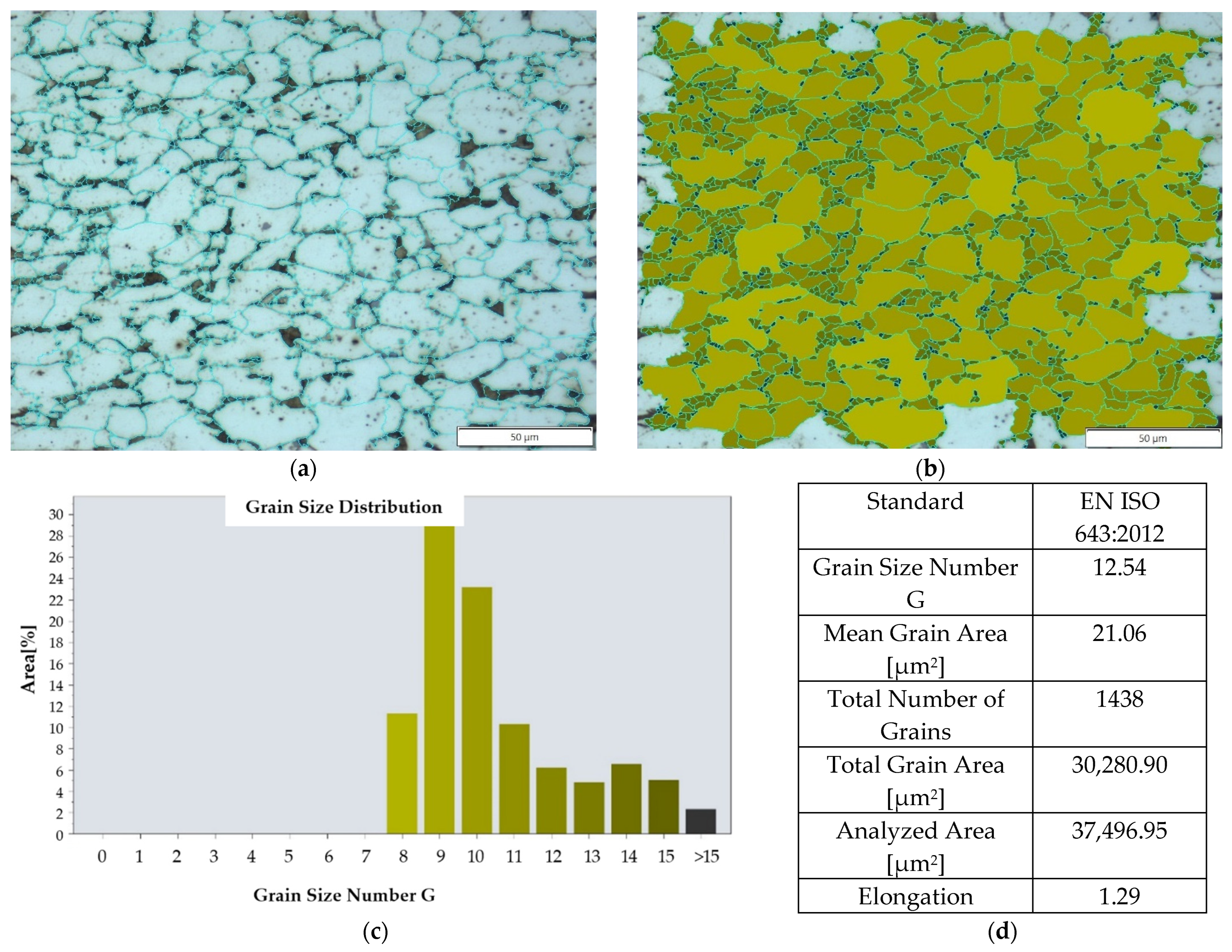

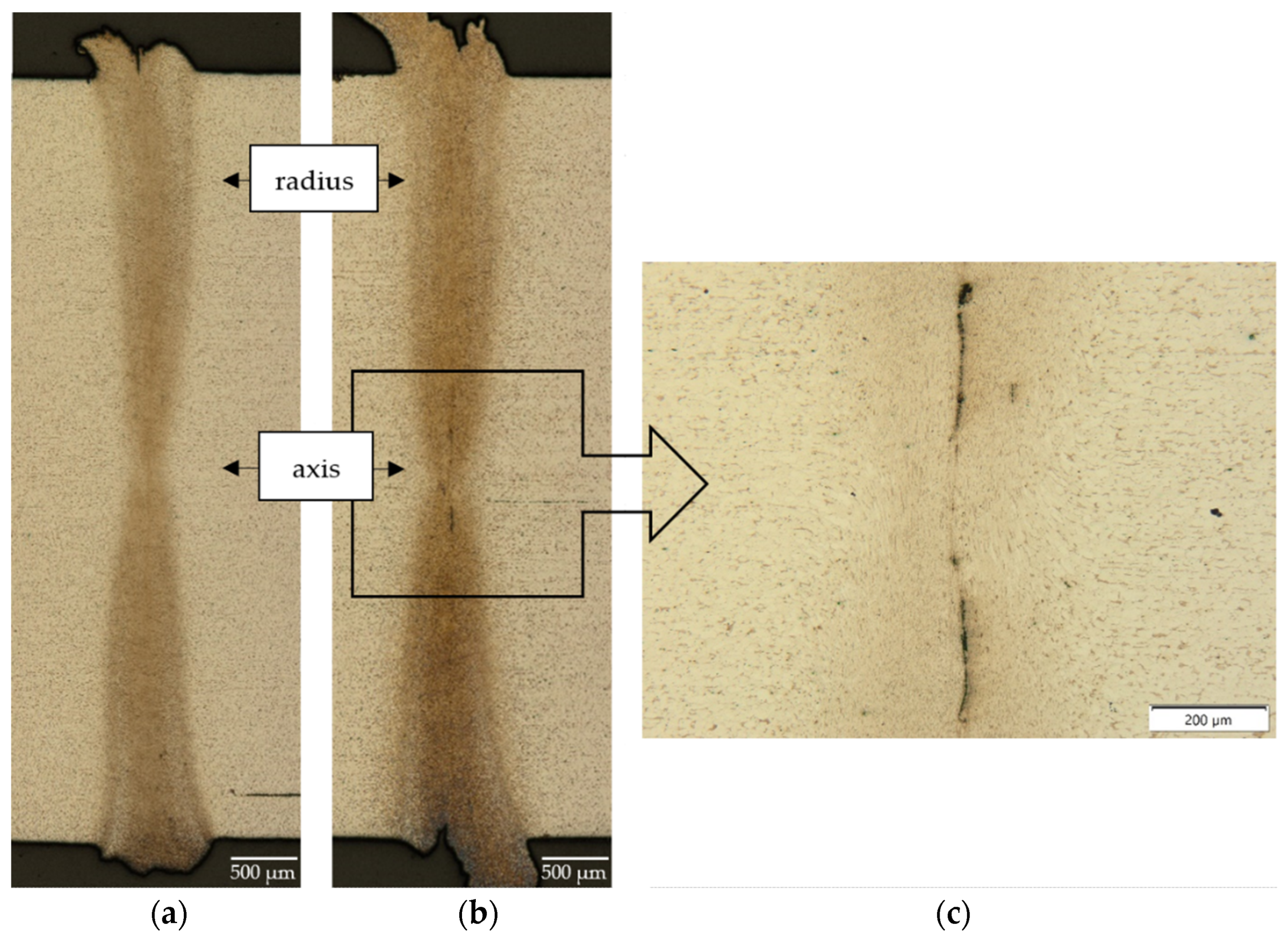
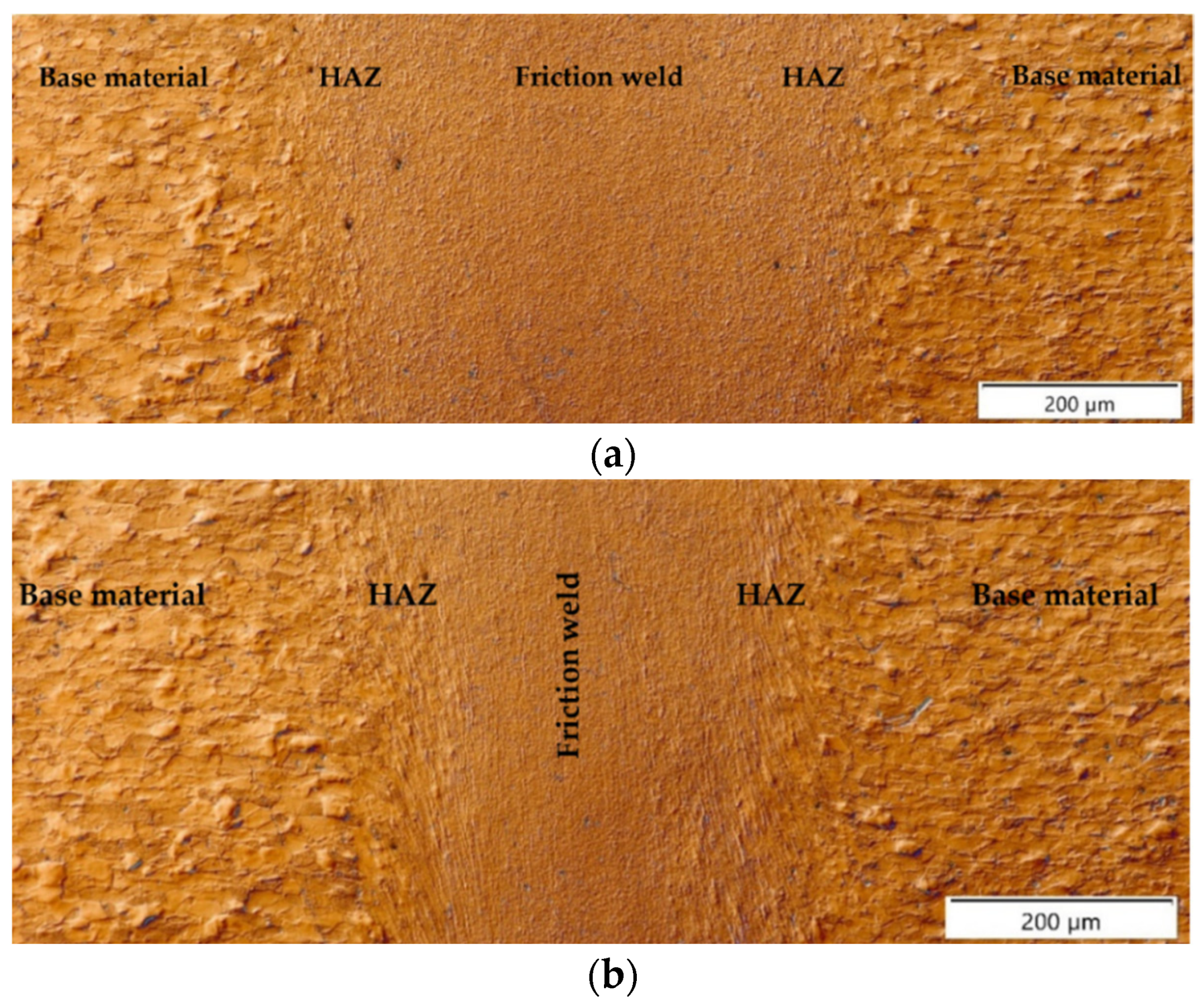
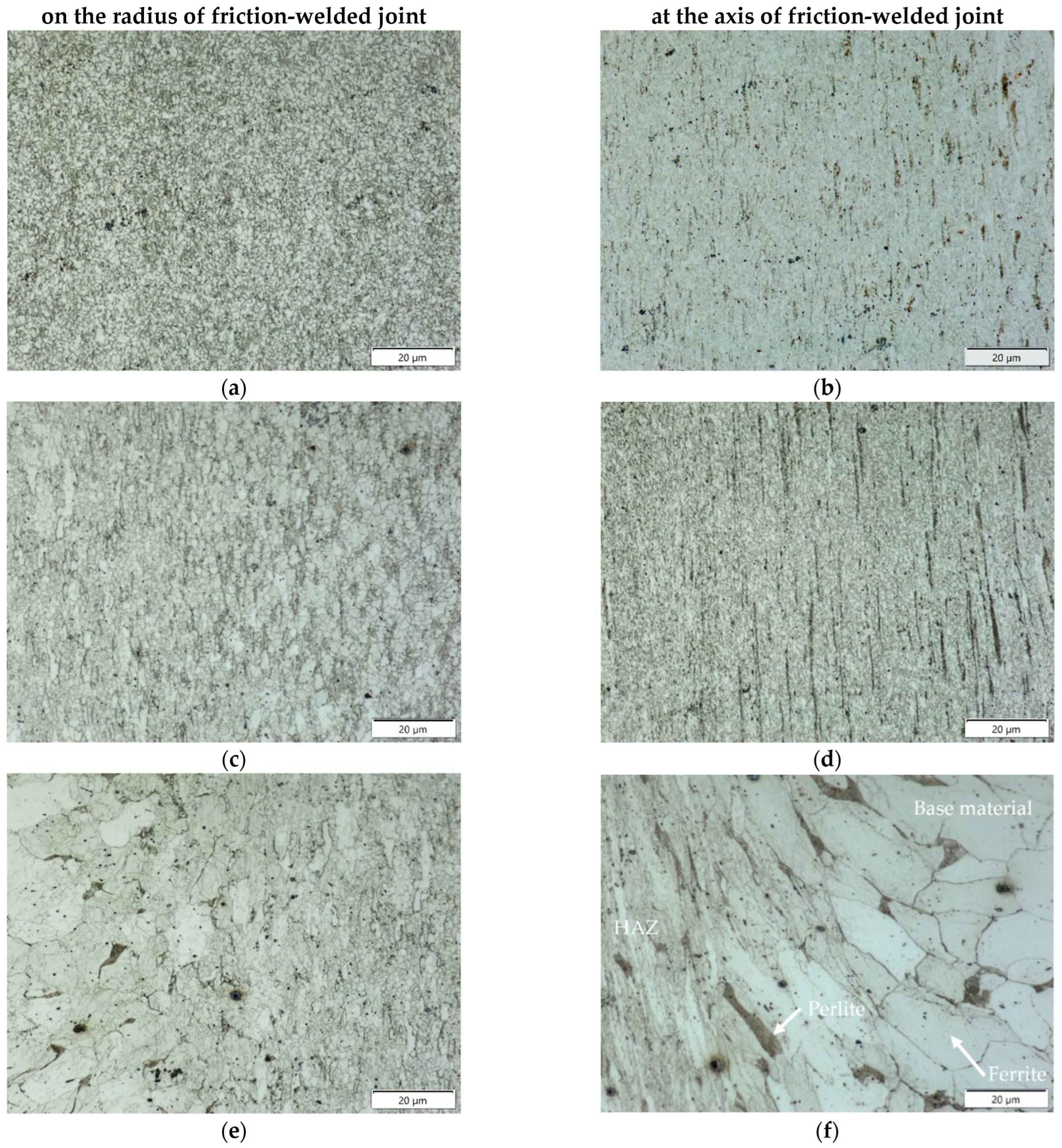
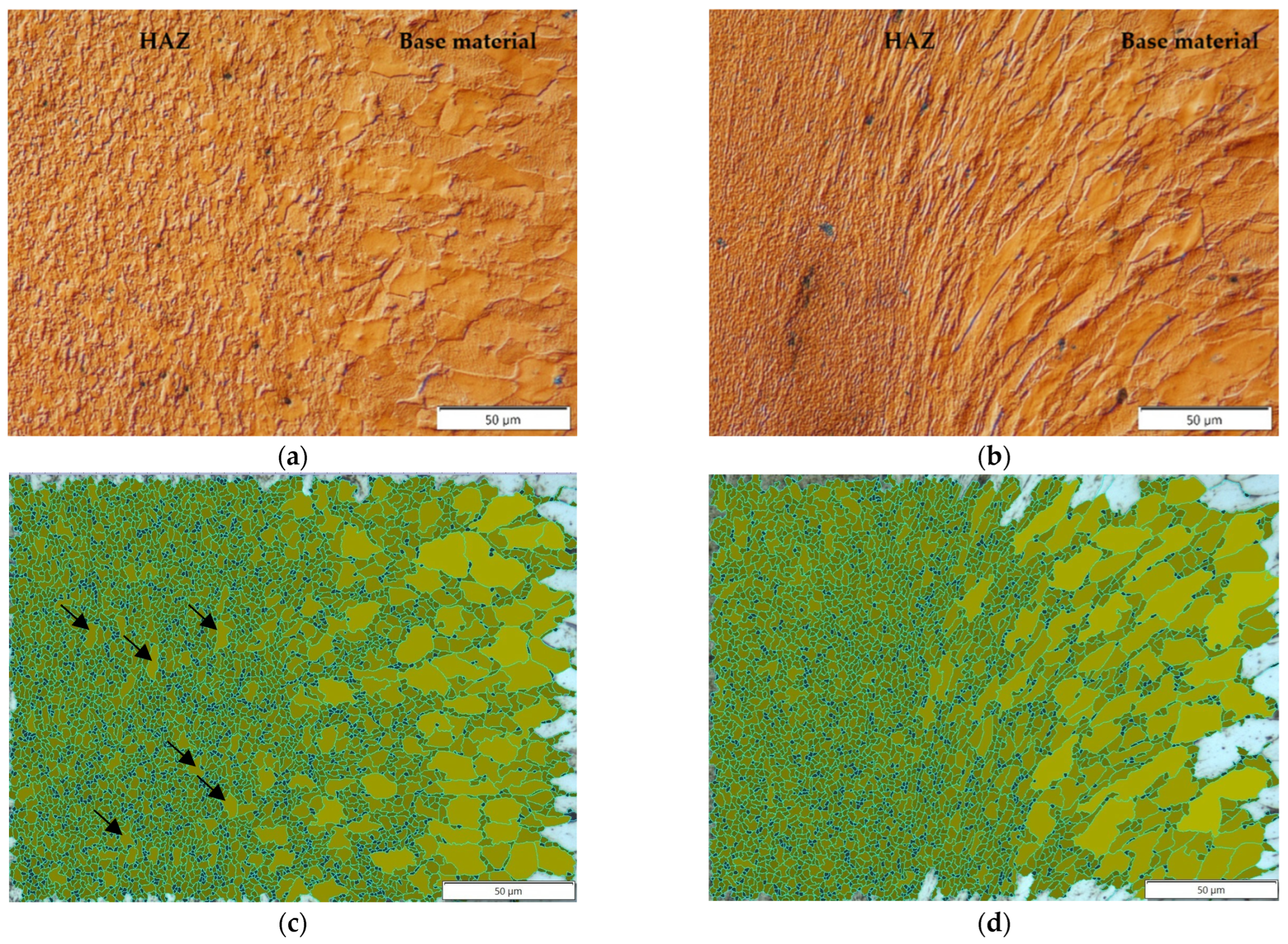
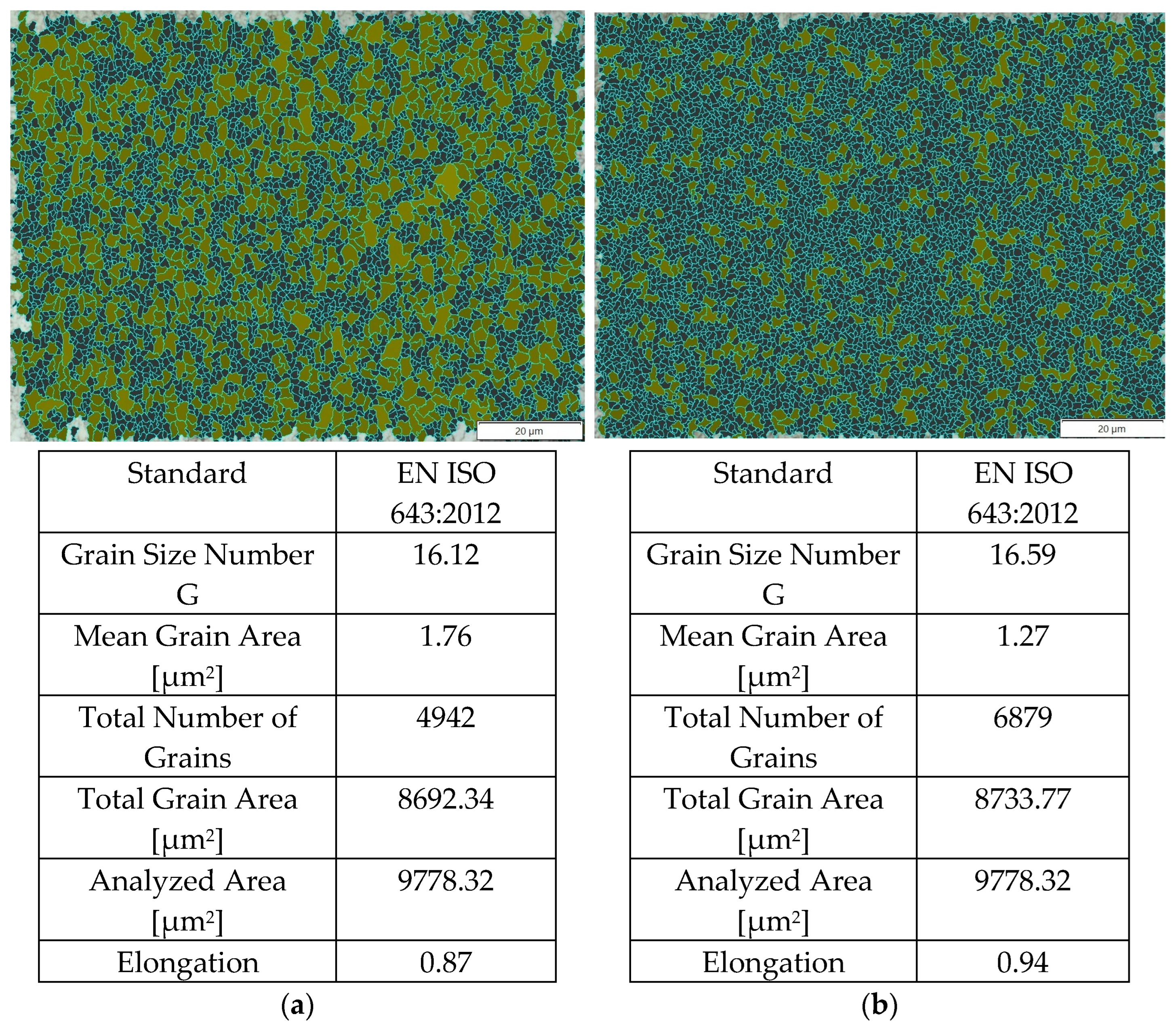
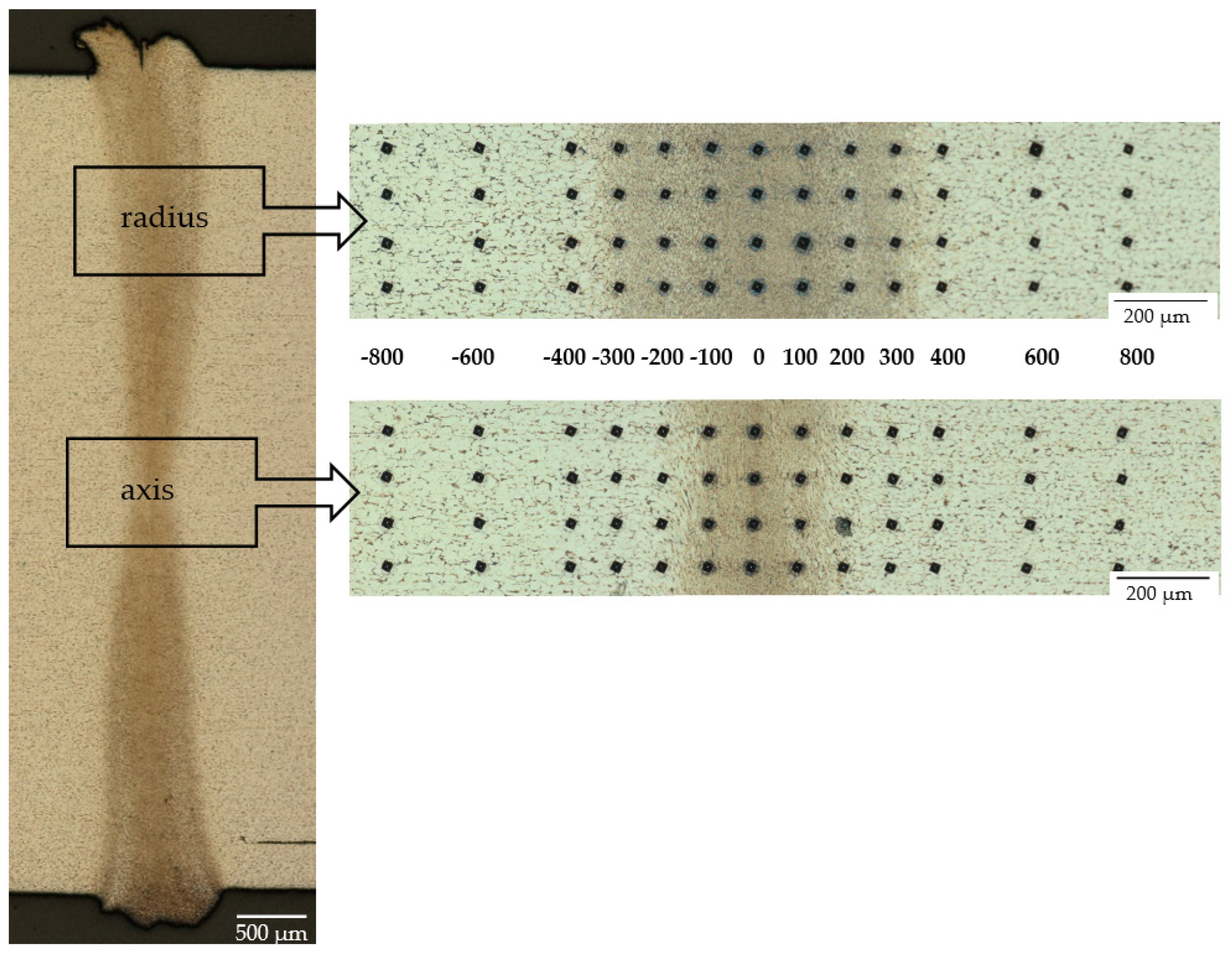
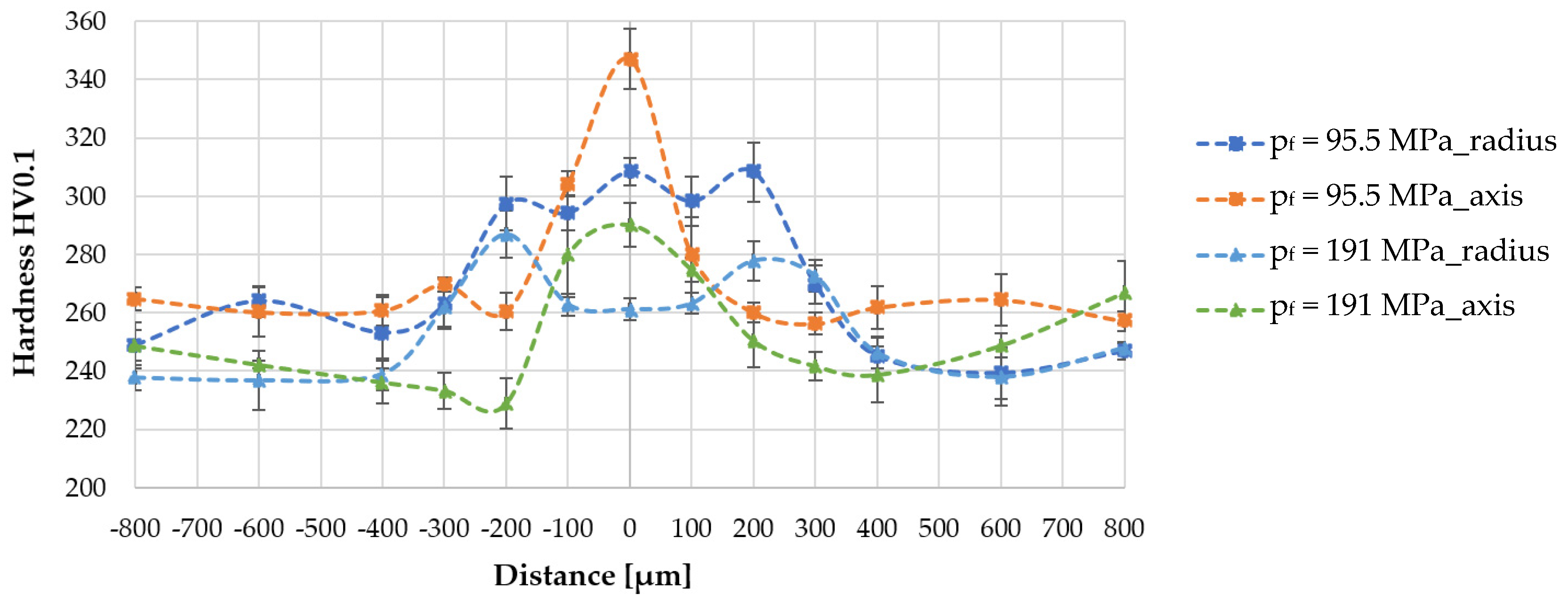
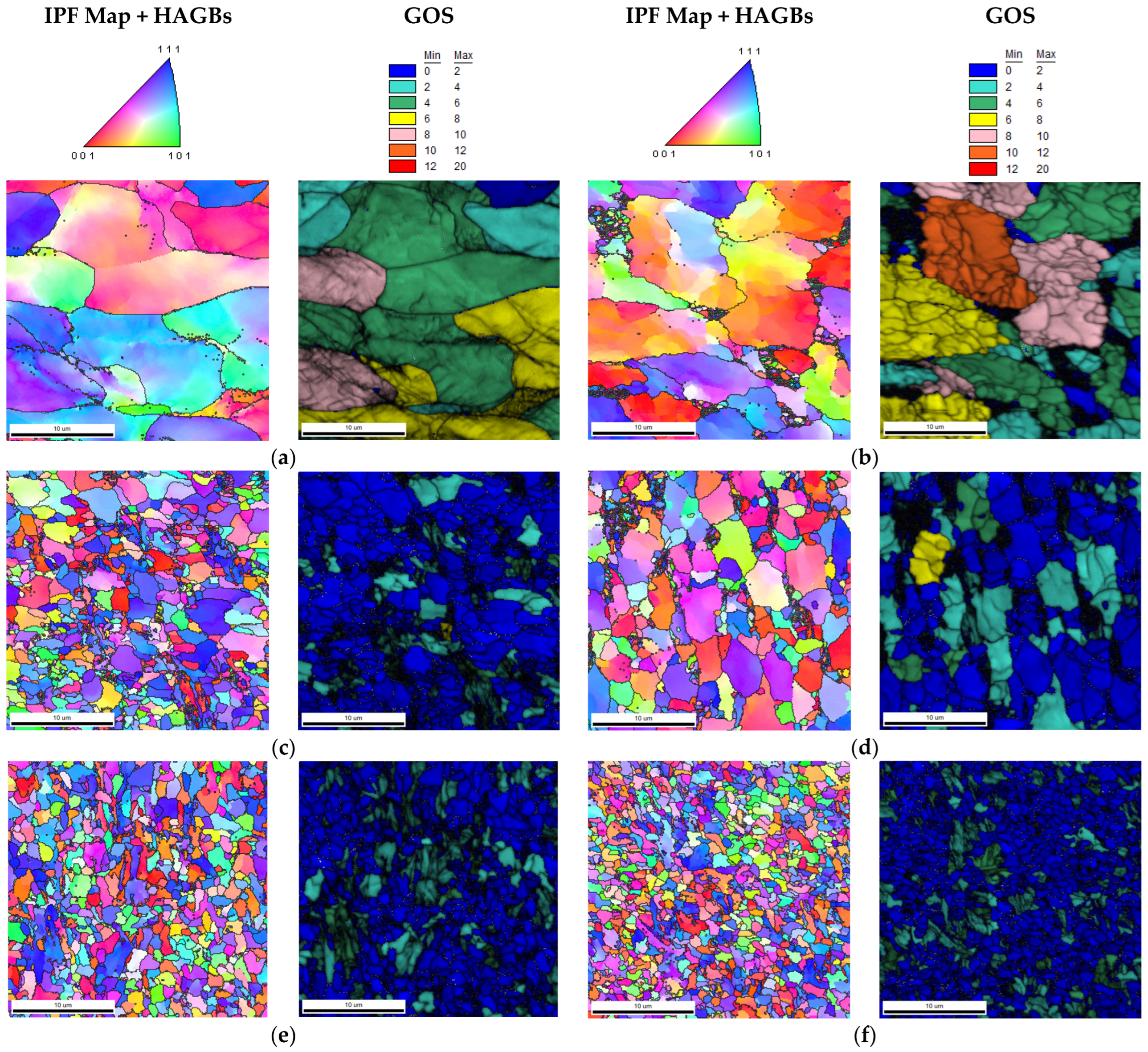
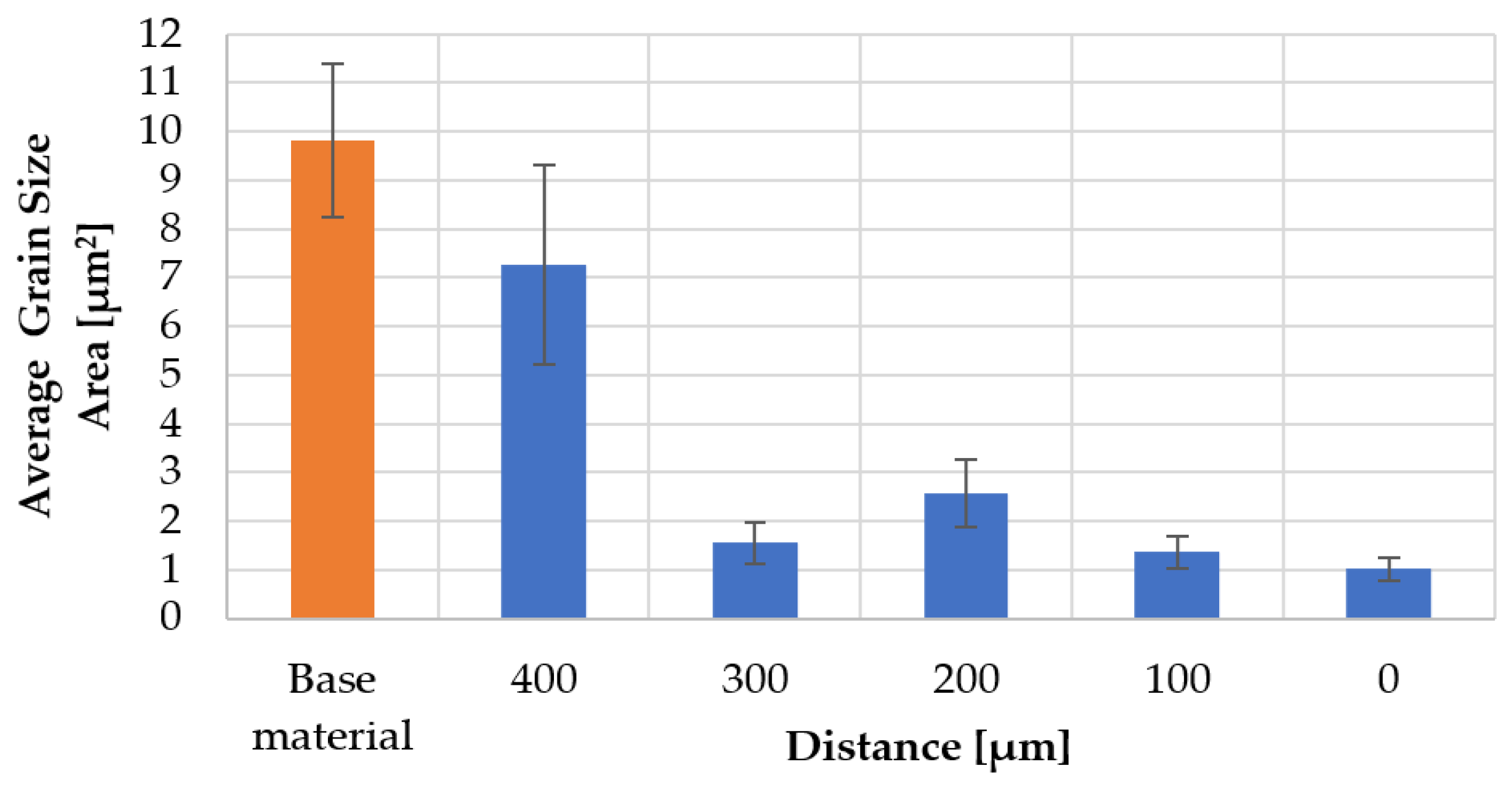
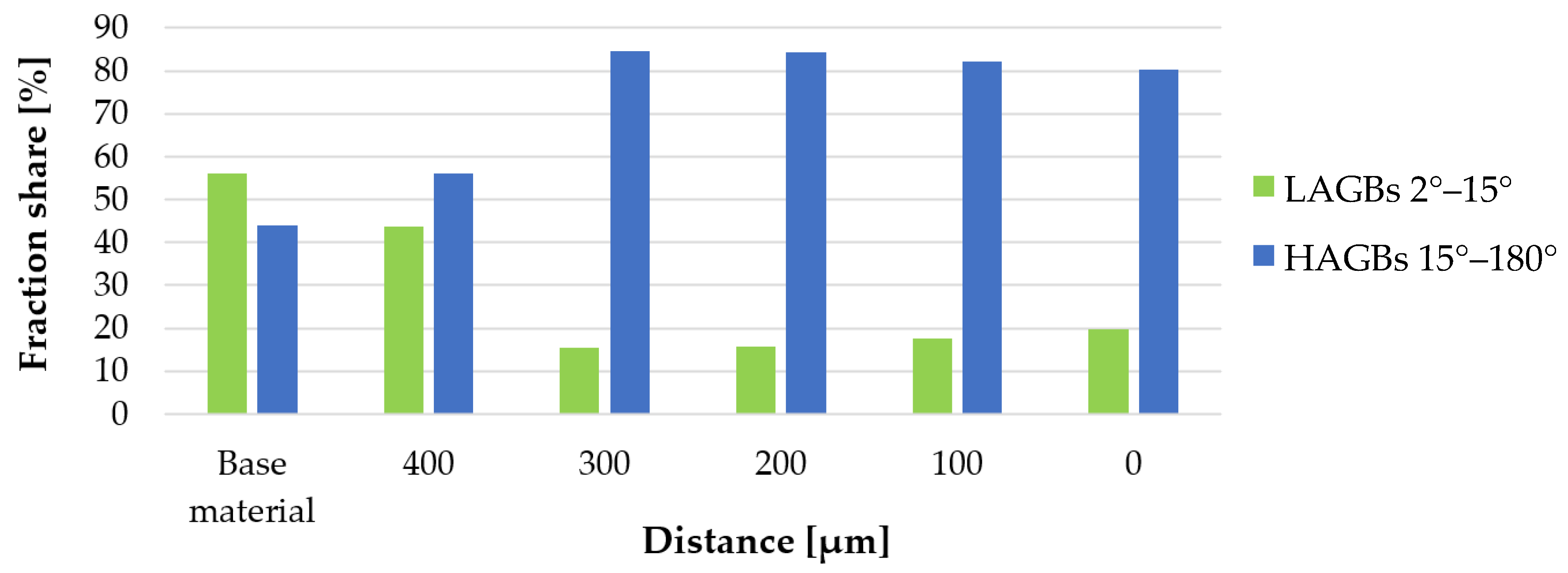
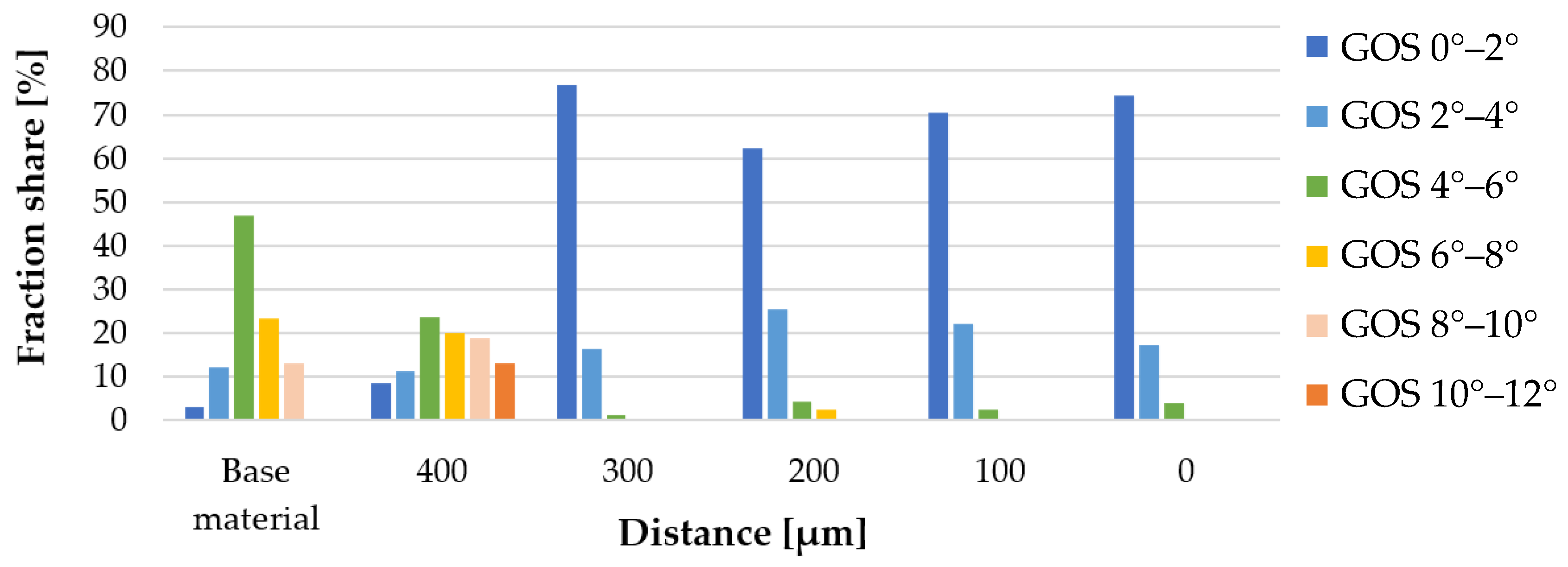
| C | Si | Mn | P | S | N | Cu | Fe |
|---|---|---|---|---|---|---|---|
| 0.069 | 0.170 | 0.510 | 0.0100 | 0.0250 | 0.0075 | 0.230 | balance |
Disclaimer/Publisher’s Note: The statements, opinions and data contained in all publications are solely those of the individual author(s) and contributor(s) and not of MDPI and/or the editor(s). MDPI and/or the editor(s) disclaim responsibility for any injury to people or property resulting from any ideas, methods, instructions or products referred to in the content. |
© 2022 by the authors. Licensee MDPI, Basel, Switzerland. This article is an open access article distributed under the terms and conditions of the Creative Commons Attribution (CC BY) license (https://creativecommons.org/licenses/by/4.0/).
Share and Cite
Skowrońska, B.; Chmielewski, T.; Zasada, D. Assessment of Selected Structural Properties of High-Speed Friction Welded Joints Made of Unalloyed Structural Steel. Materials 2023, 16, 93. https://doi.org/10.3390/ma16010093
Skowrońska B, Chmielewski T, Zasada D. Assessment of Selected Structural Properties of High-Speed Friction Welded Joints Made of Unalloyed Structural Steel. Materials. 2023; 16(1):93. https://doi.org/10.3390/ma16010093
Chicago/Turabian StyleSkowrońska, Beata, Tomasz Chmielewski, and Dariusz Zasada. 2023. "Assessment of Selected Structural Properties of High-Speed Friction Welded Joints Made of Unalloyed Structural Steel" Materials 16, no. 1: 93. https://doi.org/10.3390/ma16010093
APA StyleSkowrońska, B., Chmielewski, T., & Zasada, D. (2023). Assessment of Selected Structural Properties of High-Speed Friction Welded Joints Made of Unalloyed Structural Steel. Materials, 16(1), 93. https://doi.org/10.3390/ma16010093







